
(Gord Allison photo)
Introduction
There are a multitude of places in the Yukon bush that show little evidence of activities that once occurred there. One of these is the site of Frank Sketch’s trading post on the west side of Kloo Lake, about 32 kilometers northwest of Haines Junction. He started the post and operated it for about 30 years, and it ended with his death in 1947.
The Kloo Lake area was a busy place in the first couple of years following a gold rush there in 1903. According to newspaper reports there were stores and roadhouses (some even called hotels), and there was known to be at least one sawmill. However, the gold rush quickly faded and the associated developments were short-lived. It seems that no land applications, land surveys or maps were made that would indicate their locations, but one of the sites may be where Sketch established his trading post in circa 1917.
Why he picked this location for a trading post is a matter of speculation. It was somewhat off the beaten track, situated five kilometers off of the Kluane Wagon Road, which was the main route at the time. However, it was near a First Nations village and was on the trail to the gold mining areas of Ruby and Fourth of July Creeks. These creeks still had mining activity on them, although much less so than the initial 1903 rush. Perhaps he was simply able to take advantage of abandoned buildings, clearings and other features to use for his fur trading purposes.
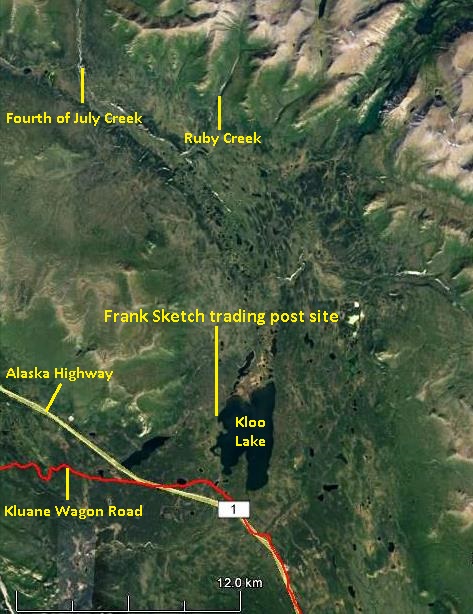
(Google Earth)
Sketch also dabbled in mining over the years he was operating his trading post, with some sources listing him as a trader and others as a miner or prospector. A combination of fur trading with the Kloo Lake area people in the winter and mining the nearby creeks in the summer may have been a natural fit for him.
The only photo I have located of Sketch at his trading post is in the Yukon Archives collection of Gudrun Sparling, the daughter of John Olaf (“Ole”) Erickson. Erickson had been mining in the Klondike region, but was in the Kluane area by 1911. At some point he and Sketch established a relationship of enough substance that Sketch later named Erickson as executor of his will. In 1925 Erickson and his wife left the Kluane area to purchase the Regina Hotel in Whitehorse, which was operated by their family for the next 70 years.
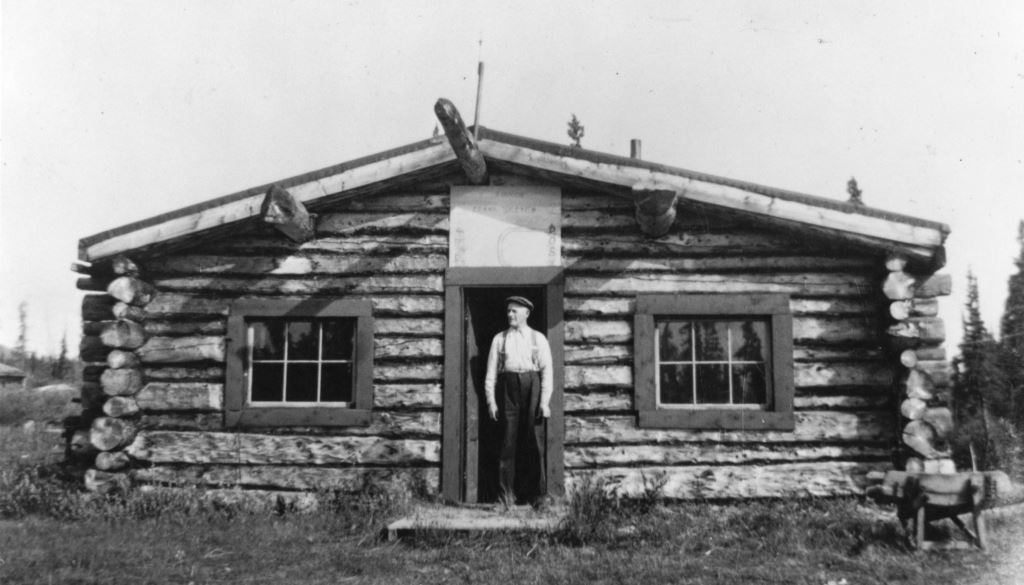
(Yukon Archives, Gudrun Sparling collection, Acc. 92-34, #1)
Sketch’s Earlier Years
Frank Sketch was born in 1878 near Victoria, BC, the fourth of five children in a farming family. When he was five years old, his parents died of illnesses within three months of each other. Before her death, his mother had appointed George Stelly, a prominent Victoria businessman, as the guardian of her children. Frank and his older brother Stephen went to live with Stelly and his family, while the eldest brother went to live with a neighbouring family and the two sisters were taken in by a local convent.
The first record of Frank being in the Yukon is in 1903, when he was working in Whitehorse as a bartender in the Hotel Grand at Front and Main Streets, where the Horwood’s building now stands. He had a couple of prior connections to the Yukon that may have piqued his interest in coming north. His brother Stephen came to Dawson with the Klondike gold rush in 1898, although he doesn’t appear to have stayed long. Also, George Stelly Jr., who Frank had lived with in Victoria in his youth, had a hotel at Bennett on the Klondike gold rush trail.
Sketch bartended in Whitehorse until at least 1912, most of those years at the Commercial Hotel. In 1908 he married a woman named Elsie and together they bought a lot in Whitehorse at what is now the location of the Champagne and Aishihik First Nations office building. His bartending career in Whitehorse was not continuous, as records show that he was in Seattle in 1910 working as a bartender in the Grand Central Hotel there. However, by 1911 he was back in the Yukon and an employee of Charles Johnston, owner of the Regina Hotel.
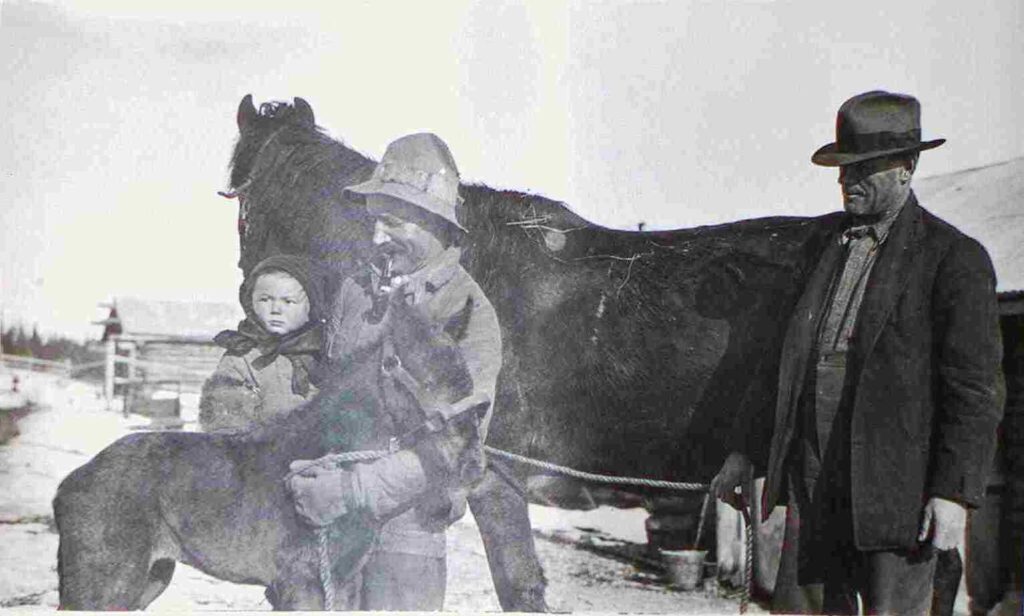
(Yukon Archives, Charles Coghlan fonds, Acc #83/19, #97 – photo has been cropped)
The Trading Post Years
At some point in or after 1912, Sketch made his way into the Kluane area, where he ended up spending the rest of his life. Whether he took over any buildings that were already there or built his own from scratch, there is no documentation of what might have been on the site at the time. He eventually had four buildings consisting of a 24’ x 20’ trading post/living quarters, a 20’ x 10’ storehouse, a 12’ x 12’ storehouse, and a 12’ x 12’ garage.
An air photo from 1956, almost a decade after the post’s closure, shows there to be buildings divided between an ‘upper’ site to the north and a ‘lower’ site about 150 meters to the south. Having two areas of buildings that far apart might support the notion that Sketch took over buildings that were already there. The largest building appears to be at the upper site, so I interpret this to be the location of his combination trading post and living quarters. I have so far not talked to anybody that might be able to provide information about the site.
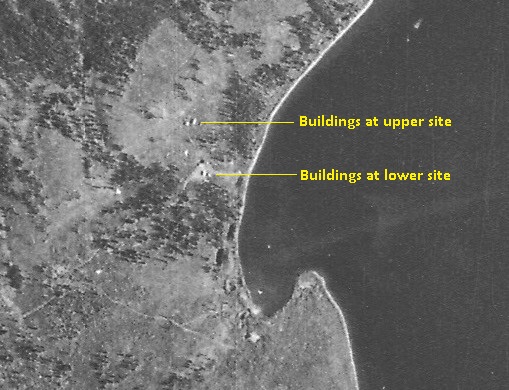
(National Air Photo Library, A15434, #3)

(Gord Allison photo)
In more remote areas of the Yukon, trappers often had to wait until after spring break-up to haul their winter’s catch to a trading post and sell them in the late spring or summer. Sketch’s post was located within a kilometer of a First Nations village, so was more accessible to those trappers and others to trade their furs during the winter and spring months. This would have enabled Sketch to close the post in the summer and engage in mining or other activities. In the 1921 census, conducted in June, he was recorded as a partner of Ole Dickson, a well-known Yukon miner, and living with him, presumably on one of the gold creeks. That census also showed that Sketch was by then a single man.
Another of Sketch’s activities, at least during the late summer and fall of 1919, was working in the big game hunting business. He was noted by author G.O. Young in Alaskan-Yukon Trophies Won and Lost (1947) as a horse wrangler for Charlie Baxter, a well-known big game outfitter. Young was hunting with a different outfitter in the White River region when his party had to be rescued from a dire situation by Sketch and others. Young described them as “among the best hearted men we ever met” and Sketch in particular as “a quiet sturdy man of few words”.
Several days later, after the end of the hunt, Sketch and another man were taking Baxter’s horses to Whitehorse along the Kluane Wagon Road. They were overnighting at the Bear Creek roadhouse, about 25 kilometers southeast of Sketch’s trading post, when the roadhouse caught on fire and was destroyed. Sketch and a couple of other men tried to get some things out of the building and ended up getting their hair and eyebrows badly singed. Sketch reported the news of the fire in Whitehorse when he arrived there.
The roadhouse was soon rebuilt, and it and the other buildings on the site were later purchased by Frank Sketch, likely in the early 1930s when the previous owner vacated them. He owned them for a few years and possibly operated the roadhouse intermittently, but the information describing this situation is somewhat confusing.
The late elder Josie (Jacquot) Sias of Silver City in an interview recounted an incident involving Sketch that is still known by some people in the Kluane area and is also recorded in G.O. Young’s book. Along with Jimmy Joe and Jack Allen, Sketch was hauling falltime freight on the Kluane Wagon Road from Whitehorse to the Jacquot brothers’ lodge and store at Burwash Landing. On crossing the log bridge over the Mendenhall River, the weight of the four horses and loaded wagon, plus a fifth horse tied on behind, collapsed the bridge. In the chaos of the situation, Sketch was kicked in the face by a horse. His eye was hanging out, so the other men put it back into the socket and tied it up with a cloth. They put Sketch on the spare horse and he headed for Steamboat Landing 14 kilometers away, where he hoped to get help. A postcard photo in a collection kept by my father Al Allison taken of Sketch and others, probably at Burwash Landing, shows him with a large bandage over his right eye. He afterwards left the Yukon and returned with a glass eye.

(Gord Allison collection)

(Gord Allison collection)
Josie Sias also talked of travelling on the Kluane Wagon Road as a child by horse and wagon as well as by vehicle. She named all the usual roadhouse stops they made and said they would include a side trip to Frank Sketch’s trading post to deliver freight to him. Vehicle travel was possible west of the Jarvis River near the south end of Kloo Lake, and therefore to the trading post, beginning in 1923. Sketch also had his own vehicle, a 1928 Model A Ford 3/4-ton truck with dual wheels and stake body that was at his post and in running condition at the time of his death.
In 1942 things changed in a big way in the Yukon with the construction of the Alaska Highway. For Sketch, one of the changes was the presence of highway construction personnel in the area, providing him with a new and larger customer base. Aside from whatever goods may have been available 25 kilometers away at Mackintosh Lodge (the new name of the former Bear Creek roadhouse), Sketch’s post was the primary store in the area. The community of Haines Junction was just a construction camp then, with no store until the late 1940’s.
Two US Army photographers took pictures in the vicinity of the trading post in 1942, and they may have been there primarily to visit the post. My father worked on the highway after the war and talked about driving in to the trading post in 1946 and buying some pants there. These new customers probably influenced the type and amount of goods that Sketch stocked in his post.
In August 1942 a US Army soldier named Ian McPherson from Michigan with the 18th Engineers Regiment working on the nearby section of Alaska Highway also evidently made his way to the trading post. There it appears he was given a first edition (1903) of “Call of the Wild” by Jack London and inscribed in it “Received from F. Sketch at Klu Lake Trading Post on this date. Yukon Territory, Canada.”
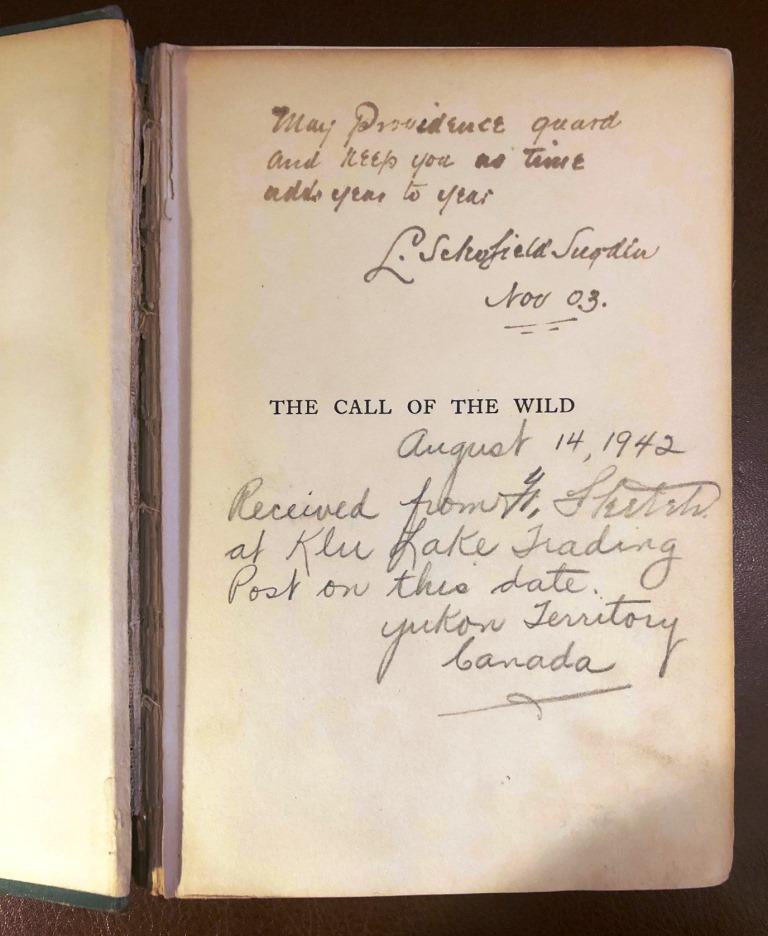
Sketch’s Death and End of the Trading Post
A nearby neighbor of Sketch on the west shore of Kloo Lake was Harry Eskrigge, who had been involved in mining in the Yukon since at least 1899. He was in the Kluane area by 1912 and was still there decades later. Eskrigge took care of the trading post when Sketch made occasional trips out of the Yukon, and he did so again for Sketch’s last trip.
Sometime in mid- to latter January of 1947, Sketch made a trip to Vancouver, but he would not return. He had cancer of the rectum and developed arteriosclerotic gangrene in his left leg, and how much of this he knew when he left is not known. On January 29 he underwent a transverse colostomy, but that did not prolong his life and he died on February 5 at the age of 68. His remains were taken to Victoria for burial in the Royal Oak Cemetery.
Eskrigge continued on as caretaker of the trading post after Sketch’s death, but he was not conducting any business. The Royal Canadian Mounted Police (RCMP) soon received a letter from Dorothy Mackintosh of Mackintosh Lodge at Bear Creek saying she had heard the trading post might close and was worried about the local people not having access to provisions. She implored the RCMP to find a way to keep the post open and offered to cover the credit of people that might have to charge their purchases. She also said that Harry Eskrigge could be counted upon to conduct any transactions honestly.
The RCMP report about this matter went on to say that Mrs. Mackintosh would purchase the staple foods at the trading post if Eskrigge would dispense with them on her behalf, to which he agreed. He was later paid by Sketch’s estate for 150 days of wages, suggesting that he kept the post open until well into the summer.
The same RCMP report also noted that Sketch had a house in Whitehorse that was being occupied rent-free by the outfitter Charlie Baxter’s widow. She was described as a close friend of Sketch and it was stated that she could remain there until further notice.
A follow-up RCMP report said that as of June 30, 1947 all of the trading post buildings and remaining contents belonging to Frank Sketch’s estate had been sold to Dorothy Mackintosh for $3,000. This marked the end of the trading post, and the buildings were either dismantled and hauled away or cut up for firewood in the following years.
An inventory of the contents of the trading post buildings was taken shortly after Sketch’s death. He must have purchased goods in large quantities and been well stocked up for the future, as the variety and amount of goods, provisions and equipment that were on hand is astounding. It is hard to imagine it all fitting in the relatively small log buildings he had. The five pages of the inventory are shown below for interest.

(Yukon Archives, Records of the Northwest Territories and Yukon Branch, MF# 31-2, File 4460)

(Yukon Archives, Records of the Northwest Territories and Yukon Branch, MF# 31-2, File 4460)

(Yukon Archives, Records of the Northwest Territories and Yukon Branch, MF# 31-2, File 4460)

(Yukon Archives, Records of the Northwest Territories and Yukon Branch, MF# 31-2, File 4460)

(Yukon Archives, Records of the Northwest Territories and Yukon Branch, MF# 31-2, File 4460)
Frank Sketch’s estate when settled seems fairly impressive for a trader/gold miner living in the bush at Kloo Lake. He had almost $260,000 in 2018 dollars in savings, bonds and assets, so his four siblings did quite well by him, each of them receiving about $59,000.
Today, more than 70 years after Frank Sketch’s death, his trading post is not a well-known piece of Kluane area history. The site is located on Champagne and Aishihik First Nations settlement land and the access road has gone back to a state that is not suitable for road vehicles. Little can be seen at the site without a close look as the remaining evidence of the activity there slowly rots away or becomes enveloped by vegetation. Though the physical evidence is disappearing, the knowledge of Frank Sketch and his trading post will hopefully be preserved.
Link to related article: The Grave of J.J. McDonald
My dad served in the US Army 18th Engineers based out of Whitehorse while building the Alcan Highway. I now have in my library a first edition (1903) of Call of the Wild by Jack London inscribed by my dad, “Received from F. Sketch at Klu Lake Trading Post on this date. Yukon Territory, Canada.” It is dated August 14, 1942. This inscription means much more now after reading this article. Thanks.
This is really great, Mark. I’m glad you now know more about the story behind your Dad’s book. Thanks so much for letting me know about it.
Thank you for the interesting and detailed history – really neat to see the inventory of the trading post, middle of nowhere and if one so desired, one could pick up a small bottle of perfume and a paintbrush! Very enjoyable read.
Thank you for reading the story and commenting. I find it mind-blowing the variety and amount of stuff he stocked at his trading post. Those highway construction workers must have been a good market for him.